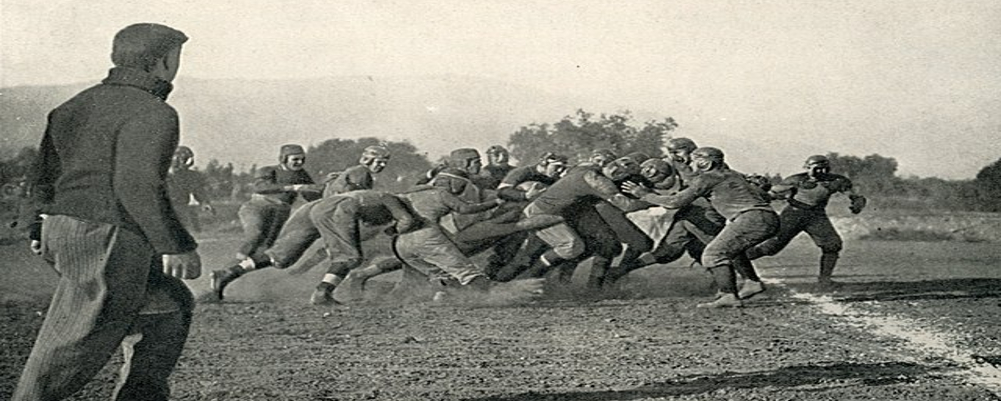Fast forward to a time overshadowed by World War II, a time when the very soul of America was tested. Yet, amidst the chaos, an unlikely story unfolded on the gridiron – the 1942 college football season. This wasn't your typical year. Join us on this podcast adventure as we delve into a season unlike any other.
Imagine a time when military training camps fielded powerhouse teams, stepping onto the field alongside established college programs. A time when a nation at war clung to the normalcy and competitive spirit offered by Saturday afternoons. We'll explore the unique circumstances that shaped this unforgettable season, from the rise of military teams to the legendary players who suited up under the shadow of war.
But this isn't just about nostalgia. We'll dissect the lasting impact of 1942 on college football. How did wartime restrictions and the influx of military talent change the game? Did it pave the way for future innovations? We'll separate fact from folklore, uncovering the true stories behind this extraordinary season.
So, buckle up, football fans and history buffs alike! Get ready for a thrilling exploration of the 1942 college football season – a season of pigskin heroes, wartime grit, and a fight for a national championship unlike any other.
Introduction to War Time Football
The 1942 college football season was one of the most memorable and impactful seasons in history due to some unique circumstances of a country at war, military teams elevated to powerhouses, and several teams vying for the national championship title. We will dive into football in Georgia, Oklahoma, Ohio, and Wisconsin as we uncover the people and games made famous in this unique season on the gridiron.
Presentation of 1942 Football Challenges
We noted that at the end of the 1941 season, Pearl Harbor was bombed by the Japanese, which triggered war declarations by the United States on Japan, Germany, and Italy. Many College-aged young men were enlisted, drafted, and recruited to serve in the military, leaving most college football programs depleted of the participants.
Rations on common supplies such as gasoline and preventative nighttime blackouts for fear of bombings restricted travel and when games could be played. Opponents were more localized than normal; however, some areas saw new teams to face in the light of military training schools and bases that were flooded with recruits.
1942 Gridiron Story Development
The collegiate brain trusts of the NCAA, along with coaches and administrators, had their hands full. No one, including the Federal government and military, wanted football suspended as it was a pleasant distraction from the horrors that the world was facing.
It would take patience, careful planning, change, and innovation to roll out a collegiate gridiron campaign that would enthrall the masses; indeed, it was a tall task to ask.
Key Games to the 1942 Season
The challenges that faced the game were minor in comparison to what was occurring on the global stage. The consequences were that the 1942 season seemed to be in trouble.
Innovation and rules revisions were deployed by rules makers to help soften the sting of manpower issues due to the Selective Service draft. The freshman eligibility rule was waived.
Free substitution was being allowed as of the end of the '41 season, with players permitted to substitute at any time but not be withdrawn or the outgoing Player returned until at least one play has commenced.
Some colleges, like Texas A&M, saw an influx of available players due to military training programs established on their campuses.
Programs that arose from the chaos
On October 31, the Wisconsin Badgers hosted the Buckeyes of Ohio State.
Former Notre Dame Four Horseman back, Harry Stuhldreher was in his seventh year as Wisconsin's head coach. Wisconsin was 5-0-1 going in the big game against OSU. The Badgers only set back was a week two tie with Notre Dame.
Coach Paul Brown was in his second year at the helm of OSU, and the system that he used in a successful High School coaching career at Massillon was being practiced well by his players after the previous year's adjustment period. The Buckeyes were undefeated thus far in the season, knocking off the likes of Fort Knox, Indiana, USC, Purdue, and Northwestern. Trouble set in, though, as during the train ride to Madison, a good portion of the Ohio State players contracted an intestinal disorder after drinking from an unsanitary drinking fountain.
Depleted in their ranks, the Buckeyes could not fend off the strong play of the Badgers, falling 7-17 to their hosts. This was the only loss for Paul Brown's team as they went the rest of the season without a blemish, taking on worthy opposition in Pitt, Illinois, Michigan, and Iowa Pre-Flight.
Perhaps still on a euphoric high after the win over their rival, the Badgers traveled to Iowa, and the Hawkeyes dashed the happiness of the Wisconsin faithful with a 7-0 victory.
In the crucible of World War II, an unlikely gridiron force emerged. The 1942 Iowa Pre-Flight Seahawks, representing the Navy's aviation training school at the University of Iowa. The Seahawks football team was coached by former Mississippi State, Tulane, and Minnesota coach Bernie Bierman soared to a 7-3 record, outscoring opponents by a commanding 211 to 121. Their losses to Notre Dame, Ohio State, and Missouri dampened the big wins over Kansas, Michigan, Minnesota, Northwestern, and Nebraska.
The 1942 and 1943 Great Lakes Navy Bluejackets football teams were coached by former Butler University coach Tony Hinkle.
The 1942 Second Air Force Bombers football team won the 1943 Sun Bowl.
✦ Ohio State Buckeyes: Big Ten champions (9-1 record), ranked #1 in the final AP Poll.
✦ Georgia Bulldogs: SEC champions (11-1 record), ranked #2 in the final AP Poll (later voted national champions by some selectors). A late season November 21 loss to rival Auburn took Georgia from the unbeaten ranks and caused uncertainty of them being the top team in the nation.
✦ Wisconsin Badgers: Big Ten runners-up (8-1-1 record), ranked #3 in the final AP Poll (selected as national champions by the Helms Athletic Foundation).
✦ Tulsa Golden Hurricane: Missouri Valley Conference champions (10-1 record), ranked #4 in the final AP Poll. The Golden Hurricane had an undefeated regular season but fell 7-14 on a New Year's Day Sugar Bowl Game against Tennessee.
✦ Georgia Tech Yellow Jackets: SEC runners-up (9-2 record), ranked #5 in the final AP Poll. Their only two setbacks of the season were in their final two games. A November 28 34-0 blanking by Georgia, followed by a New Year's Day 7-14 loss to the Texas Longhorns in the Cotton Bowl.
The Georgia Bulldogs and the UCLA Bruins tangled in the 29th Rose Bowl game on January 1, 1943, in Pasadena, California. Scoreless through the first three quarters, Georgia put up nine unanswered points in the final period: Willard "Red" Boyd blocked a Bob Waterfield punt out of bounds for an automatic safety for the first two, and then Georgia's Frank Sinkwich dove in from one-yard out for a TD and Leo Costa converted the PAT. The Bulldogs won it 9-nil. Georgia's Charley Trippi was retroactively named the Player of the Game when the award was created in 1953.
1942 statistical leaders included:
The 1942 college football season is significant in history as the resilience shown by players and teams during a challenging time still provided for a very competitive and entertaining product on the field.
✦ Frank Sinkwich of Georgia won the Heisman Trophy, becoming the first Player to surpass 2,000 yards of total offense in a season.
✦ Paul Governali of Columbia won the Maxwell Award.
✦ Rudy Mobley of Hardin-Simmons with 1,281 rushing yards
✦ Ray Evans of Kansas, with 1,117 passing yards,
✦ Harding Miller of SMU with 531 receiving yards
✦ Bob Steuber of Missouri with 121 points scored.



